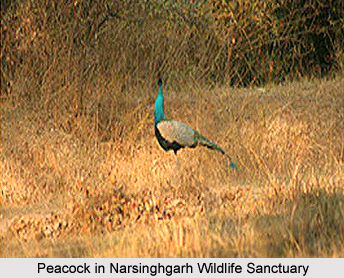 Narsinghgarh Wildlife Sanctuary is among one of the 35 sanctuaries of Madhya Pradesh. It was established in the year 1978 under Forest Division Rajgarh Social Forestry. It is situated in Rajgarh District (Rajgarh is one of smaller districts of Madhya Pradesh. It lies on the northern edge of the Malwa Plateau and two rivers form the boundary on its sides; the Parbati River forms the eastern boundary while the Kali Sindh River completes the western boundary) in the state of Madhya Pradesh.
Narsinghgarh Wildlife Sanctuary is among one of the 35 sanctuaries of Madhya Pradesh. It was established in the year 1978 under Forest Division Rajgarh Social Forestry. It is situated in Rajgarh District (Rajgarh is one of smaller districts of Madhya Pradesh. It lies on the northern edge of the Malwa Plateau and two rivers form the boundary on its sides; the Parbati River forms the eastern boundary while the Kali Sindh River completes the western boundary) in the state of Madhya Pradesh.
Narsinghgarh (Princely State of Narsinghgarh) Wildlife Sanctuary is covered 57.197 Sq. Km. in the Reserve Forest area. It is home to a large variety of flora and fauna. Major animal species found here include chital, sambar, blue bull, leopard and wild boar. There is another attraction in Narsinghgarh Wildlife Sanctuary is Chidikhon Tank. It is situated in the heart of the sanctuary. It is a habitat of several local and migratory birds. Over 164 species of birds can be sighted here. The main attraction here of the both inland and out land tourists is the peacocks.
This sanctuary is situated on National .Highway 12 (Jabalpur District-Jaipur). It is 70 Kilometres from Bhopal, the capital city of Madhya Pradesh, 221 Kilometres from Indore, 35 Kilometres from Biaora and 278 Kilometres from Kota. This Wild Life Sanctuary is located in 23 degree and 35 minutes to 23 degree and 40 minutes North latitude and 77 degree and 2 minutes to 77 degree and 10 minutes east. The average height from sea level is 462.07 to 576.08 meters. It is known as the "Kashmir of Malwa Plateau" region because of its beauty.
In the centre of this Narsinghgarh Wildlife Sanctuary, there is a lake called "Chidikho Lake. The rulers of the state build this sanctuary. In the ancient time, the local monarchs used this sanctuary for hunting purpose. The migratory birds from different places reach here in this sanctuary. The lake situated here is having special appearance due to which the local people named this lake as Chidikho Lake.
In this sanctuary, the tourists can have a glimpse of local birds and migratory birds. Dhoodh Raj, a bird inhabits in Madhya Pradesh is mainly seen here in this sanctuary. The National bird peacock is mainly seen in this sanctuary and in nearby areas. The climatic condition is suitable for the peacocks. There are some animals like Gulbagh, Cheetal are found in large numbers. Other animals like Sambhar, Nilgai are mainly found here.
Apart from the wide varieties of animals, bird and plants, there are a number of natural residual caves. These caves bear the ancient mural paintings of pre historic times.
The best time to visit the Narsinghgarh Wildlife Sanctuary is from November to June. The nearest airport is at Bhopal. Biaora Railway Station is the nearest railhead. Regular buses are available from Narsinghgarh Bus Station.



















